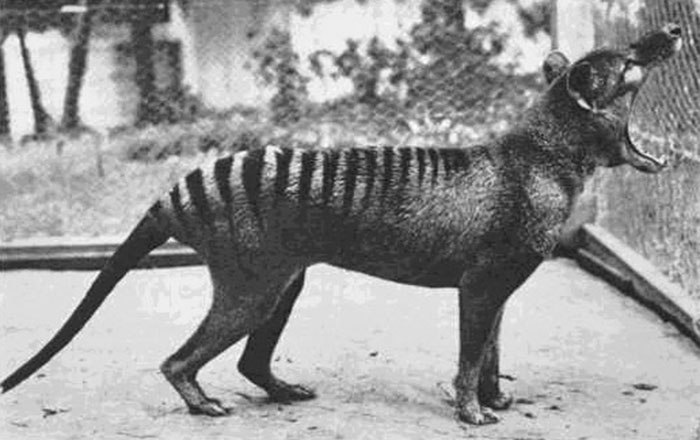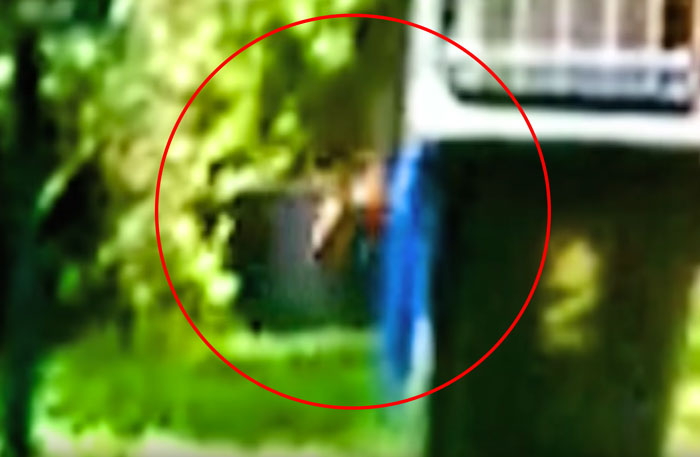Video footage has been released of what appears to be a Thylacine or Tasmanian Tiger filmed in a backyard in the Adelaide Hills.
The video was released to coincide with National Threatened Species Day and the 80th anniversary of the death of ‘Benjamin’ in the Hobart Zoo who was the last surviving captive Thylacine.
Was it a really a Tasmanian Tiger?
I've watched the footage quite a few times now and I have a theory . . Keep reading to see what I think it was . . .
So what is a Thylacine?
Thylacines or 'Tasmanian Tigers' as they were also known, were a carnivorous marsupial native to continental Australia, Tasmania and New Guinea who have been considered to be extinct since 1936.
No living Thylacines have been found on mainland Australia since white settlement and it is thought that they have most likely been extinct on the mainland for at least 2000 years.
However there have been thousands of sightings so if there are or were any actually living in the wild on the mainland in the past couple of hundred years, chances are they were Tasmanian specimens that were released here.
As European settlers moved into Tasmania in the 1800’s and first encountered Thylacines they were considered a pest and a threat to livestock and consequently the Tasmanian Government placed a bounty on them to reduce their numbers.
Between 1888 and 1909 the Tasmanian government paid £1 a head for adults specimens, paying out 2,184 bounties in total. It's thought that many more were killed and not claimed.
Through the bounty and other pressures like wild dogs, loss of prey species and potentially a distemper like disease that affected many captive Thylacine, the species was wiped out and no living examples have been conclusively seen since 1936.

So it is no surprise that there are many in Australia, myself included, who would love nothing more than for a living Thylacine to be discovered.
How incredible would it be for this beautiful animal to make a comeback?
When I heard about this new video released this week I was naturally a bit sceptical and needed to take a good look for myself.
I WANT to believe . . . but I’m not into clutching at straws.
The video snippet was filmed in someones backyard in broad daylight in the Adelaide Hills. It captures the animal slipping away behind a wheelie bin and some trees.
There are definitely features of the animal that are consistent with a Thylacine, the main one being the long straight tail with a very solid base.
You can see it clearly in this image below.


So does that mean this is a Thylacine?
Well the Thylacine Awareness Group of Australia who released the video believe it is.
But I think that when you spend a lot of time looking for something you are more inclined to focus on the evidence FOR it and ignore or downplay the evidence AGAINST.
So if it's not a Thylacine what is it then?
In my opinion, as much as I would love for this to be a Thylacine, I believe it is a fox.
Why? . . . 3 reasons why I think it is a fox
The bright red colour
Having lived in the Adelaide Hills myself I can vouch for the fact that it is teeming with foxes. You see them dead on the side of the road almost every day and I’ve dodged a few that darted in front of my car at night.
It is also not uncommon to see them in the daytime.
One of their most distinctive features is their red colour, just like the animal in the photo.
Now Thylacines were also red, so the red colour doesn’t exclude them but it does support my theory of it being a fox.
The black legs
In the video, Neil Waters refers to what may be black stripes on the back of the animal.
However I can't see the black stripes he is referring too but what is fairly clear to me is that the animal has dark coloured legs . . . just like a fox.
You can see it in the image below and it is clearer when you watch the video.


Thylacines are nocturnal
Thylacines were shy and nocturnal animals preferring to lay low and sleep in their den during daylight hours.
The likelihood of one roaming around someones backyard in broad daylight is slim.
Foxes also hunt at night but are active in the daytime as well.
It is not uncommon when driving or walking around the Adelaide Hills to see foxes trotting around and they are not as shy and wary of humans as you might think.
The probability
While we can’t say for certain that the animal in the image is NOT a Thylacine, the fact that there has been none found alive on the mainland in over 200 years of European settlement and yet the Adelaide Hills are teeming with wild foxes suggests that the animal in the video is almost certainly a fox and not a Thylacine.
For it to be a Thylacine there would have to be many more of them alive to support a breeding population which would have to have been living in the Adelaide Hills continuously for the entire time that people have been living there which is since the early 1800’s.
The chances of no-one ever finding a living specimen in all that time seems pretty unlikely to me.
Yes the tail on the animal does look a lot like a Thylacine tail but foxes also have a long tail and if this particular animal were suffering from mange which causes the loss of the animals hair then it could account for the lack of ‘bushiness’ normally associated with a fox tail.

Other options
A kangaroo
Kangaroos also have similar tails that have a wide base and there is the remote possibility that the animal in the video is a kangaroo. They are certainly common enough and can be very red in colour.
The head on the animal in the picture also looks like it could be a kangaroo.

However if it is a kangaroo then it doesn’t walk like one. The animal in the video has a definite ‘dog like’ gait which is very different to the way a kangaroo moves.
So what do you think?
Let me know in the comments below.


Some people swear they have seen a 'tiger' in the Atherton Tablelands of North Queensland.
Remnant rain forest areas remaining in our country seem too small to sustain breeding numbers over many decades, but....???
I can remember seeing a animal that was very similar to the true Tasmanian tiger running around the old mare warren tip many years ago. There were around five others there at that time. Three of the gents worked on the tip face, as I went there every day , I knew these three guys, they said that the would see this animal either first thing in the morning or around knock off time it was to quick for a photo or video.
Hmm I don't know what to think. If it has been that long since the last known thylacine I find it very hard to believe they were able to breed and roam without being seen. It makes for a very good topic of discussion though! I find myself very fascinated by it 🙂
Im with you Steve- it looks like a fox.
This is most likely a fox. Look at the 1930's filmclip of Benjamin (the last Thylacine) walking about. He has very short rear hocks and a low gait. The animal in this video has normal fox/canine length hocks and a highish step in the rear. The head does look large and solid for a fox though...
In this day and age of good quality smartphones with awesome cameras capable of capturing video footage far better than what is in this video which to me makes any identification almost impossible anyway.
A fox for the reasoning you've provided. I've seen all kinds of foxes in the adelaide hills. some are very large and there are varying colouration. i'm also a very keen hiker and typically hike 3000 km's a year in the adelaide hills searching for rare plants and fungi. There's not a park I haven't thoroughly explored over the past 6 years and I've seen an unbelievable variety of wildlife. feral pigs, goats, dog hybrids, overgrown black cats, foxes etc. I find it hard to believe I would not have eventually gazed upon a tassie tiger if there were a breeding population here. The other peculiar thing about these sightings is nobody ever tracking down these supposed thylacines. many reports of someone seeing them repeatedly in an area. Like other animals they are creatures of habit. A strategic placing of trail cams in the areas of sightings would have revealed a thylacine by now. These were animals which would feed on the livestock of farmers. They were so easy to eradicate in Tasmania because they weren't very secretive. I love the notion of the thylacine being alive and well but if it is indeed out there it must have evolved to a creature that is far more cunning than that of its tasmanian cousins.
In the picture that you overlaid with the red circle, the animal is wearing a blue collar. I saw this about a week ago whilst inspecting the video footage on YouTube. I posted a comment to this same effect on YouTube and it was subsequently deleted by the channel administrator (Neil Waters?) This is probably a dog, or someones pet Thylacine.
This would be great if it was a real Thylacine, but I remain skeptical. Most of the blurry pictures and videos I have seen appear to be foxes.
100% Fox. Look at the glaring white tipped tail. Also you can see the large fox ears get folded back as it turns its head.